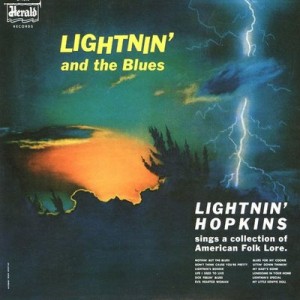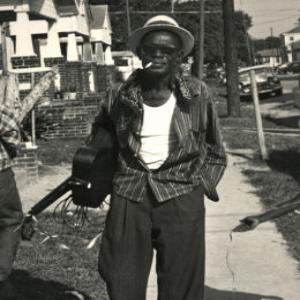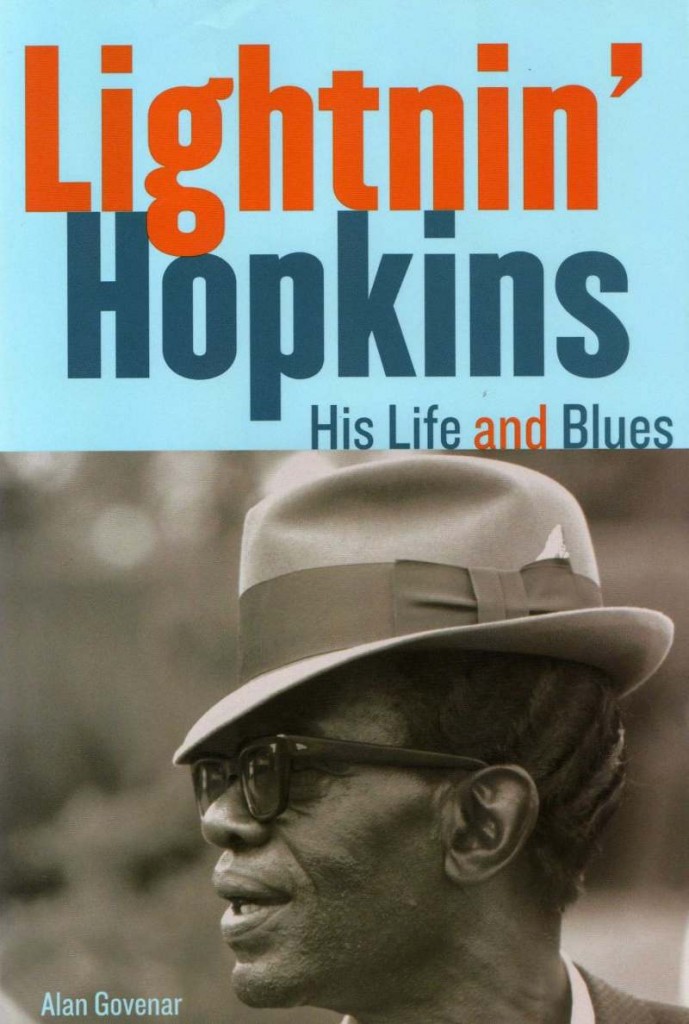With all the hoopla over the Rubber City’s favorite sons winning three Grammys (and a fourth for Dan for Producer of the Year), we shouldn’t overlook the fact that Lightnin’ Hopkins won a Lifetime Achievement Grammy – or, as the Houston Press calls it, “the Recording Academy’s way of saying ‘oops.'” Here’s a re-post in his honor.
 Are there fan clubs for dead blues guys? I should start one for Lightnin’ Hopkins. I never get tired of the signature guitar riffs he played over and over again throughout his 50-some years as a working musician. Which is a good thing, because I have about 160 tunes by Lightnin’ in my collection – still only about one-fifth of his total recorded output.
Are there fan clubs for dead blues guys? I should start one for Lightnin’ Hopkins. I never get tired of the signature guitar riffs he played over and over again throughout his 50-some years as a working musician. Which is a good thing, because I have about 160 tunes by Lightnin’ in my collection – still only about one-fifth of his total recorded output.
Lightnin’ rarely strayed from his unique “yin-yang” approach to the blues. He was a country blues guitarist who learned his craft at the feet of fellow Texan Blind Lemon Jefferson, a true master of the form. Yet he spent much of his career on the streets of Houston, often using stream-of-consciousness lyrics to describe tough characters and situations that were familiar to many urban blacks. And whether he sang or spoke those lyrics, his laconic delivery never seemed to soften the menace of his razor-sharp guitar: Nothin’ But The Blues
Rather than try to capture the full genius of Lightnin’ Hopkins in one post, I decided to focus on a set of recordings from early 1954 that I’d argue are far more rockin’ than anything Elvis later recorded at Sun Studios.
 The sessions took place in Houston and were released on the New York-based Herald label. From a commercial standpoint, these singles didn’t exactly fly off the shelves – although I’m sure they made their way onto quite a few jukeboxes in the South. Herald eventually compiled some of the songs on the 1959 album “Lightnin’ and the Blues,” which was aimed squarely at the burgeoning folk-blues movement (with this creaky sales pitch on the cover: “Lightnin’ Hopkins sings a collection of American Folk Lore”). But that release didn’t rock the charts either. In his liner notes to the 2001 CD release, Chris Smith theorizes that “white fans perhaps weren’t ready for the uncompromising rawness of Hopkins’ amplified juke joint blues.”
The sessions took place in Houston and were released on the New York-based Herald label. From a commercial standpoint, these singles didn’t exactly fly off the shelves – although I’m sure they made their way onto quite a few jukeboxes in the South. Herald eventually compiled some of the songs on the 1959 album “Lightnin’ and the Blues,” which was aimed squarely at the burgeoning folk-blues movement (with this creaky sales pitch on the cover: “Lightnin’ Hopkins sings a collection of American Folk Lore”). But that release didn’t rock the charts either. In his liner notes to the 2001 CD release, Chris Smith theorizes that “white fans perhaps weren’t ready for the uncompromising rawness of Hopkins’ amplified juke joint blues.”
But the Herald recordings had a huge impact on many a young guitar slinger – including Stevie Ray Vaughan, who seemed to have the blazing instrumental Hopkins’ Sky Hop in mind when he recorded the Grammy-nominated Rude Mood on his first album, “Texas Flood.” Apparently Lightnin’ thought so too, claiming that the tune was a “take off” on his familiar style. On this first sample, I’ve put the two songs side-by-side for the sake of further argument: Hopkins’ Sky Hop/Rude Mood
There’s probably no need to start a fight… I’m sure if someone had pointed out the similarities to Stevie Ray, he would’ve pled guilty right away. And his badass brother Jimmie has no problem connecting the dots from Lightnin’ to his own style of playing. The fact is, any modern-day Texas blues guitarist worth arguing about owes a huge debt to Lightnin’ Hopkins and the red-hot tracks he laid down for Herald in ’54.
 In his book “Lightnin’ Hopkins: His Life and Blues,” author Alan Govenar captures the significance of these recordings: “The twenty-six sides that Lightnin’ issued on Herald took his music to a new level. While little is known of what actually transpired during these sessions, the results were phenomenal. Lightnin’s amplified guitar had an explosiveness that had not been heard before, but note for note, Donald Cooks on bass and Ben Turner on drums – two session players in Houston – were completely in synch with his every lick.” Here’s more evidence that Lightnin’ and his band came to play: My Baby’s Gone
In his book “Lightnin’ Hopkins: His Life and Blues,” author Alan Govenar captures the significance of these recordings: “The twenty-six sides that Lightnin’ issued on Herald took his music to a new level. While little is known of what actually transpired during these sessions, the results were phenomenal. Lightnin’s amplified guitar had an explosiveness that had not been heard before, but note for note, Donald Cooks on bass and Ben Turner on drums – two session players in Houston – were completely in synch with his every lick.” Here’s more evidence that Lightnin’ and his band came to play: My Baby’s Gone
The band’s undeniable chemistry is even more remarkable when you consider Lightnin’s casual approach to chord changes, time signatures and other basic musical signposts. Like his contemporary John Lee Hooker, Lightnin’ had a highly original and distinctive style of playing that often was best expressed in solo performances, where he would hang on to a chord or a groove for as long as he felt it. And obviously, this approach didn’t always translate well to a full-band setting. Probably the best advice anyone could give one of his backing musicians was simply “hang on tight.” As drummer Robert Murphy complained, “Some nights we’d jam, we’d go all night. And the next night, we’d be somewhere different, we’d play a little while, and he would just turn around and tell the people, ‘Well, folks, I don’t think me and this drummer are gonna make it.’” (From an essay by John Wheat: “Lightnin’ Hopkins: Blues Bard of the Third Ward.”)
Govenar rightfully notes that the Herald sessions “anticipated the rock explosion of 1955 and 1956.” But Lightnin’, who already was in his early 40s when he made those landmark recordings, couldn’t compete with more youthful rock ‘n rollers like Elvis and Little Richard. Regardless, I never understood why the Herald recordings, although clearly in the blues vein, aren’t commonly recognized as vital artifacts of early rock. Listen to the big, booming rhythm on this next cut. Just once, I’d like to hear Lightnin’ blasting from one of those ridiculously jacked-up car stereos… Moving On Out Boogie
 “Whatever he did in his day-to-day life, when he stepped into that studio, he was on fire,” Govenar wrote. But Lightnin’ walked away from the Herald sessions with little fanfare. He remained a regional blues favorite who still had to scrape and hustle for every dime he made. Only a few months later, Elvis would stroll into Sam Phillips’ studio in Memphis and record the first of his groundbreaking singles for Sun Records. Of course we all know who became the household name. But Lightnin’ was able to exact a little revenge in the early Sixties when he kick-started a whole new career on the folk-blues circuit while Elvis was doing everything he could to become completely irrelevant.
“Whatever he did in his day-to-day life, when he stepped into that studio, he was on fire,” Govenar wrote. But Lightnin’ walked away from the Herald sessions with little fanfare. He remained a regional blues favorite who still had to scrape and hustle for every dime he made. Only a few months later, Elvis would stroll into Sam Phillips’ studio in Memphis and record the first of his groundbreaking singles for Sun Records. Of course we all know who became the household name. But Lightnin’ was able to exact a little revenge in the early Sixties when he kick-started a whole new career on the folk-blues circuit while Elvis was doing everything he could to become completely irrelevant.
Over the years, Lightnin’ became one of the most prolific recording artists of any genre, waxing some 1,000 tunes on countless labels. I don’t pretend to be an expert on that massive discography. I just know what I like – which includes virtually everything I’ve picked up over the years with the name Lightnin’ Hopkins on it. And especially the Herald sessions of 1954. Early Mornin’ Boogie
Lightnin’ on video – from the 1967 documentary “The Blues According to Lightnin’ Hopkins,” by Les Blank. With Billy Bizor on harmonica.
Here’s another clip (short one) from the same documentary… Lightnin’ playing at a party. Do those kids know how lucky they are?




Your excellent review above of the Hopkins biography neatly dovetails with that of the ever dependable Ron Weinstock (JazzBlues 328, August 2010)
========================================
Lightning’ Hopkins:
His Life and Blues
Alan Govenar
Chicago Review Press 2010: 368 Pages
One of the blues most iconic artists, Sam “Lightnin’” Hopkins, is the subject of a welcome new biography from writer and photographer Alan Govenar. Govenar has written a number of books including “Texas Blues : The Rise of a Contemporary Sound,” as well as a musical “Blind Lemon Blues,” that has been performed Off-Broadway. Hopkins was celebrated during his life for his ability to spin songs seemingly out of the blue, for his sometimes acerbic commentary on people, the relationships between men and women and current events, while performing for two very different audiences, the urban working class folk that bought his commercial recordings and frequented the bars in Houston’s black community and the white audience that was first introduced to his music during the folk revival and later when he became one of the most respected performers on the blues circuit from the sixties through his death in 1982.
Hopkins was born in rural Centreville, Texas. At the time Texas was pretty racist, with lynchings happening far too frequently. In this world, life was rough and hard and often violent. Hopkins’ dad was shot to death over a card game when he was three. Shortly thereafter his oldest brother, John Henry left because he would have killed the man who shot their dad. He grew up in a world of country suppers and square dances, and had to share in the farm work. he learned to play guitar as well as dance as a youngest and this enabled him to give up the hard life of farm work. Relying on interviews of those who knew the young Hopkins, as well as Hopkins’ own recollections (some were issued on one of the many recordings he made), Govenar shows the develop of the young artist who would spend time with Blind Lemon Jefferson and Texas Alexander. Alexander was a particularly important person for Hopkins and their travels together would be reflected in some of his repertoire.
Hopkins would settle into Houston whose Black Com- munity had a varied night life ranging from the upscale El Dorado Ballroom Club to neighborhood bars for the working and country folks. It was the later venues that Lightnin’ would play at. To middle and upper-level residents of the Third Ward, he was likely invisible. Then he was discovered by Lola Cullum, who had discovered Amos Milburn and had taken the pianist out to California where he recorded for Aladdin Records in 1946. As a follow-up to Milburn’s success she brought Hopkins and pianist Wilson “Thunder’ Smith to record. While Hopkins played on Smith’s “Rocky Mountain Blues,”, Hopkins on acoustic guitar, Smith on piano and a drummer, he recorded “Katie Mae Blues,” and “Mean Old Twister.” It was at the session that Cullum nicknamed Hopkins Lightnin’. These recordings would start one of the most prolific recording careers in blues history and were unusual in the use of acoustic guitar, since Hopkins played electric on nearly every recording he made until he recorded during the folk revival when some producers insisted (based on some false notion of authenticity), that he play acoustic. Not all did so, as Chris Strachwitz who started Arhoolie Records in part because of Hopkins. Strachwitz had been a fan of Hopkins juke box recordings and would record Hopkins using electric guitar for the recordings that would be issued on Arhoolie as well as some he made for other labels such as Poppy (later reissued on Tomato).
Govenar tracks Hopkins’ recordings after his initial Aladdin sides, through he recordings at Bill Quinn’s studio for Gold Star and other labels, Bobby Shad, the Herald label and then Mack McCormick who was first to record Hopkins for the folk music market, followed by Samuel Charters, Strachwitz and others. Hopkins, like his contemporary John Lee Hooker, was one who would record for any label willing to pay him, and he insisted in being paid in cash which may relate to Hopkins having minimal education and essentially being illiterate as well as a general mistrust of whites. So he would insist on cash payments, and eschew royalties. Then he would complain he was underpaid by the record company, while asserting he received substantial cash payments.
Govenar traces Hopkins’ career as a recording artist and performing artist, noting the changing nature of those who booked and managed him. Mixed in are accounts of his performances including recollections of those who saw his performances and his differing persona for his two different audiences, who related to his music in fundamentally different fashions. The interaction between Lightnin’ and those watching him at the Third War neighborhood bars was far different from the restrained, but attentive white audiences that proved to much more financially lucrative. While Hopkins had a guarded personality, he does flesh out some of his personality as well as provides a cogent discussion of Lightnin’s songs and music, ranging from his ability to spin songs out of current events to his development of “Mr. Charlie,” which with his spoken introduction, became a staple of his performance.
“Lightnin’ Hopkins: His Life and Blues” is a celebration of Hopkins’ life and music. There are a couple of minor factual errors. There is a reference to a performance at Toronto’s New Yorker Theatre which John Hammond opened as being in 1978, but unless this was a repeat booking, I am certain this show was in 1977 because I was living in Buffalo and went with my friend Paul to catch this show, one of the two chances I had to see him perform. In 1978 I was living in the New York area, and did not return to Toronto until 1984. Also Terry Dunn, the owner of Tramps, was remembered as a Texan but in fact was an Irish immigrant whose origins would be hard to miss. Still these are minor errors and do not detract from the invaluable biography Govenar has provided us.
In addition to extensive endnotes and a selected bibliography, Andrew Brown and Alan Balfour have contributed a fifty page discography of Hopkins extensive recording career which includes much new information including correcting the identity of the steel guitarist who recorded with Hopkins in 1949 for Gold Star. It was Hop Wilson, not Frankie Lee Sims as long suggested, who can be heard on “Jail House Blues,” and “‘T’ Model Blues.” In addition to Govenar’s narrative, this discography ensures that this will be the standard reference on Hopkins for years to come. In summary, this is an invaluable addition to the blues.